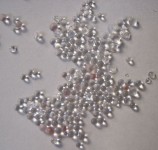KRUNAL ACID AGENCY - AHMEDABAD
- Home
- Krunal Acid Agency
- Silica Gel
Silica Gel
Silica gel is a granular, vitreous, porous form of silicon dioxide made synthetically from sodium silicate. Silica gel is tough and hard; it is more solid than common household gels like gelatin or agar. It is a naturally occurring mineral that is purified and processed into either granular or beaded form. As a desiccant, it has an average pore size of 2.4 nanometers and has a strong affinity for water molecules.
Silica gel is most commonly encountered in everyday life as beads in a small (typically 2 by 3 centimetres (0.79 × 1.2 in)) paper packet. In this form, it is used as a desiccant to control local humidity in order to avoid spoilage or degradation of some goods. Because of poisonous dopants (see below) and their very high absorption of moisture, silica gel packets usually bear warnings for the user not to eat the contents.
Properties
Silica gel's high surface area (around 800 m²/g) allows it to absorb water readily, making it useful as a desiccant (drying agent). Once saturated with water, the gel can be regenerated by heating it to 120 °C (250 °F) for two hours. Some types of silica gel will "pop" when exposed to enough water. This is caused by breakage of the silica spheres when contacting the water.
Hazards
Silica gel is non-toxic, non-flammable, and non-reactive and stable with ordinary usage. It will react with hydrogen fluoride, fluorine, oxygen difluoride, chlorine trifluoride, strong acids, strong bases, and oxidizers. Silica gel is irritating to the respiratory tract and may cause irritation of the digestive tract, and dust from the beads may cause irritation to the skin and eyes, so precautions should be taken. Some of the beads may be doped with a moisture indicator, such as cobalt(II) chloride, which is toxic and may be carcinogenic. Cobalt (II) chloride is deep blue when dry (anhydrous) and pink when moist (hydrated). Self-indicating (blue to pink) silica gel was reclassified by the European Union as of July 2000 as a toxic material due to the heavy metal cobalt which forms part of the moisture sensitive indicator. Self-indicating (orange) silica gels (orange to green and orange to colorless) are non-toxic and non-flammable.
Crystalline silica dust can cause silicosis but synthetic amorphous silica gel is indurate, and so does not cause silicosis.









